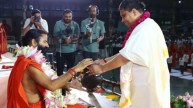In Varanasi—the city of saints and sarangis, where every ghat whispers verses of eternity and the Ganga flows like a timeless raga—was born a voice that would one day become synonymous with India’s most evocative musical tradition: thumri. Girija Devi was not merely a singer; she was a phenomenon. A master of subtlety and surrender, she transformed classical music into a language of the soul, accessible to connoisseur and commoner alike.
Her voice, like the holy river she grew up beside, carried the scent of devotion, the ache of longing, the lilt of mischief, and the gravitas of wisdom. To call her the Queen of Thumri is to offer only a fraction of her legacy. She was a portal—through her, one entered the living history of Purab ang, the lyrical plains of Bhojpuri, the courtesan salons of Lucknow, the quiet alleys of Kabir Chaura, and the inner sanctum of the self.
I had the extraordinary opportunity to speak with Girija Devi ji a few times over the phone. Her voice, even in casual conversation, was silken—graced with the same elegance and weight it carried on stage. We spoke of thumri, its place in the larger cultural landscape, and of other musical legends whom she hailed with such grace and generosity. I remember telling her, “Appaji, I will definitely come to meet you for an interview.” She had smiled through the phone, her tone gentle yet commanding, and we both hoped that the meeting would soon happen. Though destiny had other plans, those conversations remain among my most cherished memories.
Her daughter, Sudha ji, and I eventually began working together on a prospograph—an exploration of Girija Devi ji’s artistic journey. Sudha ji became a wellspring of insight, helping me understand not just the music but the spirit of the woman behind it. Through our discussions, I could see the world Girija Devi had shaped—one where grace, tradition, and individuality coexisted beautifully. Even today, Sudha ji and I share a warm bond, built on mutual reverence for a legend whose essence we both hold dear.
Born in 1929 in Kabir Chaura—a neighbourhood that has gifted the world some of India’s greatest musicians—Girija Devi’s life was destined to be interwoven with melody. Her father, Ramdev Rai, a zamindar with a deep love for music, recognised the glimmer of promise in his daughter’s early renditions of folk wedding songs she would sing to her dolls. In a time when the classical arts were often considered taboo for women, especially from ‘respectable’ families, it took conviction and courage to nurture that promise. But Ramdev Rai was no ordinary father. He believed that talent was divine and must not be stifled by society’s blinkered gaze. And so, he led young Girija to her first guru, Pandit Sarju Prasad Misra—a sarangi virtuoso and vocalist of the highest calibre.
What followed was not just a musical education but a lifelong surrender to art. Under the stern yet affectionate guidance of Misra ji, Girija Devi trained in khyal and tappa. These forms demanded precision, discipline, and years of devotion. But even amidst their grandeur, her heart kept leaning toward a different realm—the more fluid, emotional, and poetic world of thumri.
Thumri, often misunderstood and once relegated to the margins of “serious” classical music, became her sacred territory. She restored its dignity, not through protest, but through pure excellence. Her performances were not simply recitals; they were storytelling sessions drenched in rasa—where Radha’s longing for Krishna in a dadra or a chaiti could just as easily reflect the modern woman’s yearning, where seasons changed in her voice, and festivals came alive through her bhava.
Her renderings of seasonal forms—Kajri, Hori, Chaiti—remain unparalleled. One could sense the fragrance of first rain in her Kajri, the riot of colours in her Hori, and the quiet melancholy of separation in her Birha. But even beyond the better-known structures, Girija Devi explored rarer musical jewels—Gulnaqsh, Parmatha, Tappa, Rubai. She delved into these lesser-sung forms with the same intensity, breathing new life into forgotten traditions.
It was not merely the variety of forms that distinguished her, but the emotional clarity with which she expressed them. When she sang of longing, it wasn’t abstract—it was tangible, like a letter never sent, a glance never returned. Her voice could shift from laughter to tears in a single phrase, moving her listeners not just with technique, but with truth.
In one of our conversations, I asked her about the elegance that surrounded her not only as an artist but as a woman. In her subtle humour and warmth, she said, “Beta, you must come and see my sarees, and my paan too.” Indeed, her identity was steeped in aesthetics—whether it was the graceful silk sarees she wore, her perfectly tied silver hair, or the ever-present paan that she so fondly relished. She embodied a rare kind of tradition—one that was not stifled by the past, but enriched by it.
In my unpublished notes from that conversation, I had scribbled: “She carries the essence of a bygone era—the calm of temple bells, the poetry of old letters, and the fragrance of marigolds.” It was perhaps the most apt description I could conjure. There was something old-world about her, yet she was never dated. She had the rare ability to remain timeless.
Banaras, her muse and her mirror, permeated every note of her music. There’s something about that city that demands both discipline and abandon—a paradox Girija Devi embodied so effortlessly. The ethos of the city—its leisurely afternoons, its philosophical banter, its twilight aartis—lived within her renditions. She was not only of Banaras; she was Banaras.
Her artistry earned her every accolade one can imagine—Padma Shri, Padma Bhushan, Padma Vibhushan. But perhaps the highest honour was the reverence she inspired in her peers. Legends bowed before her. Stalwarts like Ustad Bismillah Khan, Pandit Bhimsen Joshi, and Begum Akhtar held her in the highest esteem. Not because she sought it, but because she embodied a dignity that demanded it.
One of her devoted disciples, Sunanda Sharma—whom I lovingly refer to as Sunanda Didi—graciously shared with me some of the most captivating insights into the world of Girija Devi ji. She spoke of how, whenever Appaji sang Malhar, there was an uncanny connection with nature itself. “Jab bhi Malhar gaogi, baras jayega,” she would say with a serene confidence—and, almost magically, it would rain. The very air seemed to tremble in response to her voice, as if the ragas themselves obeyed her call. Sunanda Didi also spoke with great reverence about the Guru-Shishya Parampara that defined their bond. She described how every lesson imparted by Appaji was far more than just a technical teaching; it was a transmission of deep, spiritual wisdom—a thread linking past to present, carried forward with grace, humility, and respect. Through Sunanda Didi’s stories, I was able to catch a glimpse of what it truly meant to be one of Appaji’s disciples: it was a journey not only of musical mastery but of understanding the very essence of tradition, culture, and the soul.
Malini Awasthi, a close disciple of Girija Devi, often reminisces about the profound bond they shared. In her words, “Appaji was more than a mother to me,” . Their relationship transcended the traditional guru-shishya dynamic, evolving into a deep familial connection. Malini recalls the first time she heard Appaji sing at the Vindhyachali Mandir in the early 1970s, an experience that left an indelible mark on her. Years later, in 1988, after hearing Malini perform at the Bhatkhande Jayanti in Lucknow, Girija Devi offered to mentor her. However, understanding the importance of personal commitments, she advised Malini to prioritize her marriage, assuring her that the path of music would always be open.
This anecdote not only highlights Appaji’s nurturing nature but also her deep understanding of life’s rhythms, much like the thumris she so masterfully rendered. Through Malini Awasthi’s heartfelt tributes and performances, the legacy of Girija Devi ji continues to resonate, echoing the timeless melodies of the Banaras Gharana.
Beyond performance, she was a devoted teacher. At institutions like the ITC Sangeet Research Academy and the Banaras Hindu University, she mentored countless students. Her legacy, therefore, is not only in recordings but in living voices that continue to echo her style, her spirit, and her sensitivity.
To remember Girija Devi is to remember a time when music was not hurried, not packaged, not performative—but meditative. She reminded us that classical music was not meant to intimidate, but to illuminate. That thumri was not a relic, but a river—always flowing, always fresh.
Even today, when I hear the gentle turn of a phrase in a dadra, or a bhajan rendered with quiet intensity, I feel her presence. Her music lingers in the silence between two notes. In the hesitation before a taan. In the sigh at the end of a line. It exists not just in recordings, but in the very ethos of Indian music.
In her passing, we lost a voice. But in her life, she gave us a vision.
As the Ganga continues its timeless journey through the ghats of Varanasi, so too will the music of Girija Devi—flowing, nourishing, and eternal.
Rhythm Wagholikar is a distinguished Indian author, cultural columnist, and social activist. Renowned for his evocative tributes to legends like Lata Mangeshkar and Girija Devi, he seamlessly blends storytelling with cultural preservation. Collaborating with Rachana Shah, he has co-authored acclaimed works such as Swarlata and The Soul Stirring Voice. Beyond literature, Rhythm’s commitment to social causes, especially supporting orphans, underscores his dedication to creating a positive societal impact.












